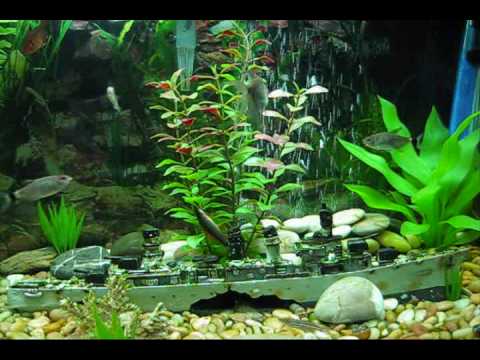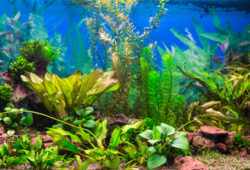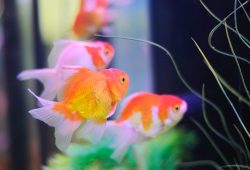Oddballs for the community tank
The article gives a detailed analysis of Oddballs for the community tank. Many so-called oddball fish are perceived of as specialist and difficult to keep. While this is true in some cases, many oddball species are not too demanding so long as a little research is done to determine their needs.

There are even a few that can be kept in more general community tanks with a little extra attention to their dietary needs.
None of the species suggested here present a danger to medium
to large community fishes such as gouramies, medium-sized barbs, larger tetras, rainbowfish and most catfish.
The only fish likely to be at risk from some of the species are small slim tetras such as Neons and Glowlights, or similar species. The species covered are also relatively common in aquarium stores, so shouldnt be too difficult to find.
Ropefish
The Ropefish or Reedfish, Erpetoichthys calabaricus, from Africa is easily recognised by its elongated eel-like body which, unlike its relative the Polypterus, features no pelvic fins.
It is said that wild specimens have been measured up to 90cm/36″, but most aquarium specimens are unlikely to exceed even half that size, and usually make about 30cm/12″.
Due to their eel-like bodies, they can be accommodated in relatively small tanks, say 90 x 30cm/36″ x 12″ base area as a minimum for one or two (height is less important).
Whatever the tank size, make sure it has tight-fitting covers as these fish are notorious escape artists!
These peaceful bottom-dwellers are best kept in a group. They are not aggressive. The only fishes likely to be at risk are small fishes such as Neon tetras that might be eaten when resting near the bottom at night.
Ropefish seem particularly fond of bloodworm, but will also eat catfish pellets as well as small pieces of mussel, prawn and baitfish.
They are best kept on a soft sand substrate, though smooth gravel would be suitable. Provide a few hiding places in the way of rocks or bogwood caves, or live or artificial plants.
Although newly imported fish
can be problematic, this fish is very hardy once acclimatised. Parameters suitable for most community fish will be fine: slightly acidic to fairly alkaline, soft to medium hard.
Water quality should be maintained as with any fish by suitable filtration and regular water changes. As always, aim for zero ammonia and nitrite, with nitrate as low as possible. A temperature around 26C/79F is recommended.
Elephantnose
The common Elephantnose, Gnathonemus petersii, is an oddball in every sense. The “trunk” is a sensitive organ used for locating food.
It comes from central Africa and grows to around 20cm/8″ in aquaria. A 90cm/36″ tank is recommended, larger for a group. Due to the sensitive trunk, a soft sand substrate is preferred. These fish show a preference for frozen or live foods, particularly bloodworm, and often refuse dry foods.
They are not aggressive towards other fish, but show some territoriality towards other elephantnoses.
Therefore it is better to keep either a single specimen, or a group large enough to diffuse any aggression. When only two or three are kept, a dominant individual is more likely to bully a less dominant one.
Provide plenty of caves for retreats, especially if several specimens are kept. Dim lighting is preferable, or shade from tall stem plants and floating plants.
Soft and slightly acidic water is preferable to mimic natural conditions, though they appear to do fine in harder, slightly alkaline water.
A temperature of 25C/77F will suit them fine. Mormyrids like the elephantnoses tend to be more sensitive to medications, so always read the small print before using any.
Snakeheads
Snakeheads are a group of fish not normally associated with making good companions for other fish! However, while some snakeheads are the last thing you would ever want in a community tank, there are some smaller species with a much milder temperament. One is the Rainbow snakehead, Channa bleheri.
This strikingly coloured snakehead grows to about 15cm/6″ at most. Larger community fishes such as gouramies, rainbowfish and Clown loaches should be perfectly safe.
This species is not overly active but has endearing character traits. They will often lay motionless among plants, seemingly day-dreaming. Then they shoot out from their resting place if a favourite food item drops past. Foods can include frozen or live bloodworm, pieces of mussel, cockle or prawn, and earthworms.
They have a curious nature I have seen them carefully examine a new addition to the tank, running their external nostrils along the newcomer, but showing no inclination towards aggression. They are, however, territorial towards their own kind, or similar-looking fishes.
This is a very hardy species that does not require any specific water chemistry, as long as extremes are avoided. Gentle current is preferred.
Make sure the tank has a tight-fitting cover with no gaps as the snakehead is another escape artist! If you ever discover one on the carpet, it’s worth returning it to the tank as they will usually recover as long as they haven’t completely dried up.
Spiny eels
Spiny eels are not true eels but have long, eel-like bodies. They originate from Asia and Africa, and the family has now been subdivided into four genera.
The genus Mastacembelus contains well-known spiny eels such as the Fire eel, Mastacembelus erythrotaenia, and Tyre-track eel, Mastacembelus armatus.
These two species grow too large for a more general community tank. However, there are some smaller ones. Among these is Macrognathus circumcinctus, sometimes known as the Half-banded or Bar-bellied spiny eel. It may be found in stores
simply as “Striped spiny eel”.
This attractive little eel grows to about 15cm/6. Its colour can vary from vertical bars to horizontal light and dark bands in the same individual at different times.
They are shy fish and appreciate caves of wood or rocks to retreat to. They also bury themselves in a soft substrate, so sand is preferred to gravel. Often they will be observed with just their head peeking out from their favourite resting place.
Frozen or live bloodworm and brineshrimp seem to be favourite foods, though small pieces of other meaty foods can be offered, such as mussel and earthworm.
This species seems to thrive in a range of water, so soft to medium hard and acidic to slightly alkaline water will be fine. Temperature should be around 24-26C/75-79F.
Leopard bush fish
The Leopard bush fish or Spotted climbing perch, Ctenopoma acutirostre, is a labyrinth fish hailing from the Congo basin of Africa. It has an accessory organ allowing it to make use of atmospheric air.
This species usually reaches about 10cm/4 in aquaria. It is naturally a predatory fish, though anything larger than a platy should be OK.
They are not aggressive towards other fish, but are territorial towards their own kind. Keep a group of similar-sized individuals in larger tanks.
A planted tank will suit them best, perhaps with a few floating plants. A few pieces of bogwood or rock caves could complete the decor. The type of substrate is not critical. Good bio-filtration is required, but not too strong a flow.



